belt FORD EXPEDITION 1997 1.G Owners Manual
[x] Cancel search | Manufacturer: FORD, Model Year: 1997, Model line: EXPEDITION, Model: FORD EXPEDITION 1997 1.GPages: 224, PDF Size: 2.2 MB
Page 9 of 224

Brake system warning
Extinguishes when the parking
brake is released. Illumination after
releasing the parking brake
indicates low brake fluid level.
Safety belt
Illuminates when the ignition is
switched on to remind you to
fasten your safety belts. For more
information, refer toUsing the
safety restraints properlyin the
Seating and safety restraints
chapter.
Air bag readiness
Briefly illuminates when the
ignition is turned to On. If the light
fails to illuminate, continues to
flash or remains on, have the
system serviced. For more
information, refer to
Supplemental restraints system
(SRS)in theSeating and safety
restraintschapter.
Check engine warning light
This light illuminates when the
engine's Emission Control System
requires service. It will also
illuminate when the ignition key is
in the On position and the engine
is off. Refer toWhat you should
know about the On-board
diagnostic (OBD II) systemin the
Maintenance and carechapter.
!
BRAKE
CHECK
ENGINE
com_safety_belt.01
exd_air_bag
exd_check_engine
exd_tcil_light
Instrumentation
10
Page 12 of 224

Check air suspension
Illuminates briefly when the
ignition is turned to the ON
position and the engine is OFF.
The light also illuminates when the
air suspension system requires
servicing.
Testing warning lights
Turn the ignition key to ON
without starting the vehicle. The
warning and indicator lights shown
above will illuminate for a brief
time. If any of these lights do not
illuminate, contact your dealer for
service.
Safety belt warning chime
For information on the safety belt
warning chime, refer to the
Seating and safety restraints
chapter.
Supplemental restraint system
(SRS) warning chime
For information on the SRS
warning chime, refer to the
Seating and safety restraints
chapter.
CHECK
SUSP
3
1050
3070
4080
120
140
40
20
0
10090 60
8060100
20 km/h
0010
0000052
4
5
6 01LH
CH
EF
818
THEFT
RPMx1000LOW
RANGE
4x4 FUEL
RESET CHECK
ENGINEABS
DOOR
AJARLOW
FUEL3
1050
3070
4080
120
140
40
20
0
10090 60
8060100
20 km/h
0010
0000052
4
5
6 01LH
CH
EF
818
THEFT
RPMx1000ABS
BRAKELOW
FUEL!
exd_testing_warn_lights
com_safety_chime.01
com_srs_chime.01
com_key_chime.01
Instrumentation
13
Page 75 of 224
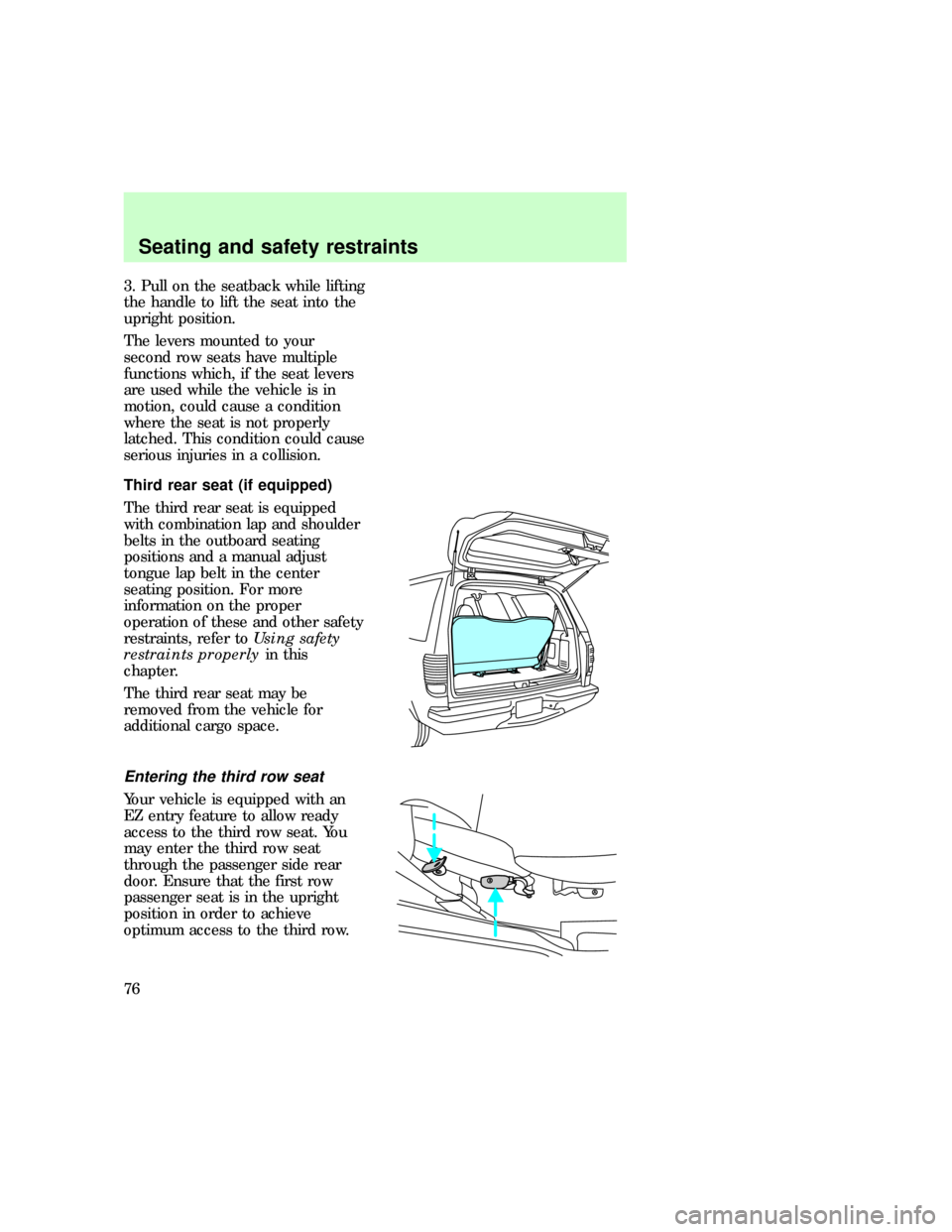
3. Pull on the seatback while lifting
the handle to lift the seat into the
upright position.
The levers mounted to your
second row seats have multiple
functions which, if the seat levers
are used while the vehicle is in
motion, could cause a condition
where the seat is not properly
latched. This condition could cause
serious injuries in a collision.
Third rear seat (if equipped)
The third rear seat is equipped
with combination lap and shoulder
belts in the outboard seating
positions and a manual adjust
tongue lap belt in the center
seating position. For more
information on the proper
operation of these and other safety
restraints, refer toUsing safety
restraints properlyin this
chapter.
The third rear seat may be
removed from the vehicle for
additional cargo space.
Entering the third row seat
Your vehicle is equipped with an
EZ entry feature to allow ready
access to the third row seat. You
may enter the third row seat
through the passenger side rear
door. Ensure that the first row
passenger seat is in the upright
position in order to achieve
optimum access to the third row.
exd_third_seat
Seating and safety restraints
76
Page 76 of 224
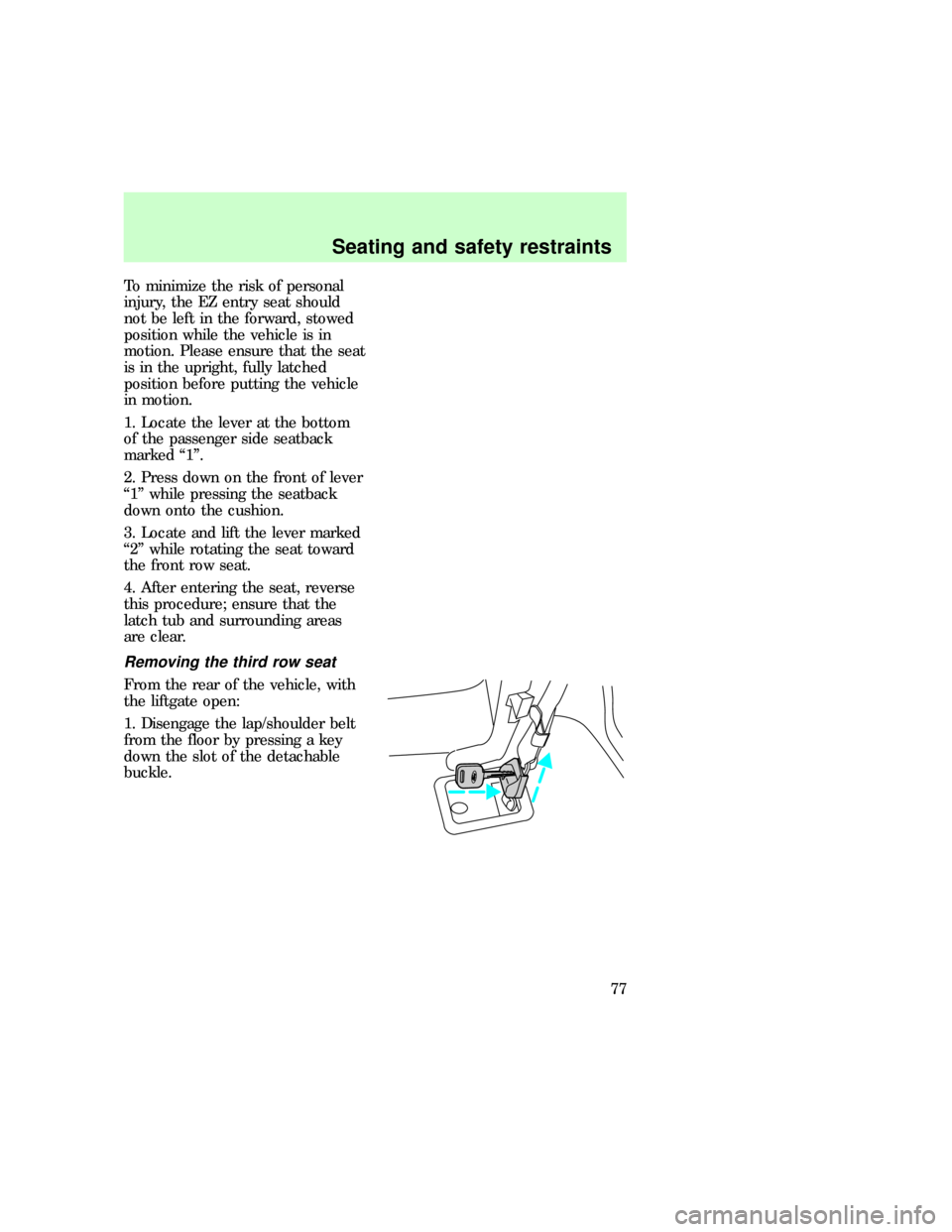
To minimize the risk of personal
injury, the EZ entry seat should
not be left in the forward, stowed
position while the vehicle is in
motion. Please ensure that the seat
is in the upright, fully latched
position before putting the vehicle
in motion.
1. Locate the lever at the bottom
of the passenger side seatback
marked ª1º.
2. Press down on the front of lever
ª1º while pressing the seatback
down onto the cushion.
3. Locate and lift the lever marked
ª2º while rotating the seat toward
the front row seat.
4. After entering the seat, reverse
this procedure; ensure that the
latch tub and surrounding areas
are clear.
Removing the third row seat
From the rear of the vehicle, with
the liftgate open:
1. Disengage the lap/shoulder belt
from the floor by pressing a key
down the slot of the detachable
buckle.
exd_removal_third_seat
Seating and safety restraints
77
Page 77 of 224
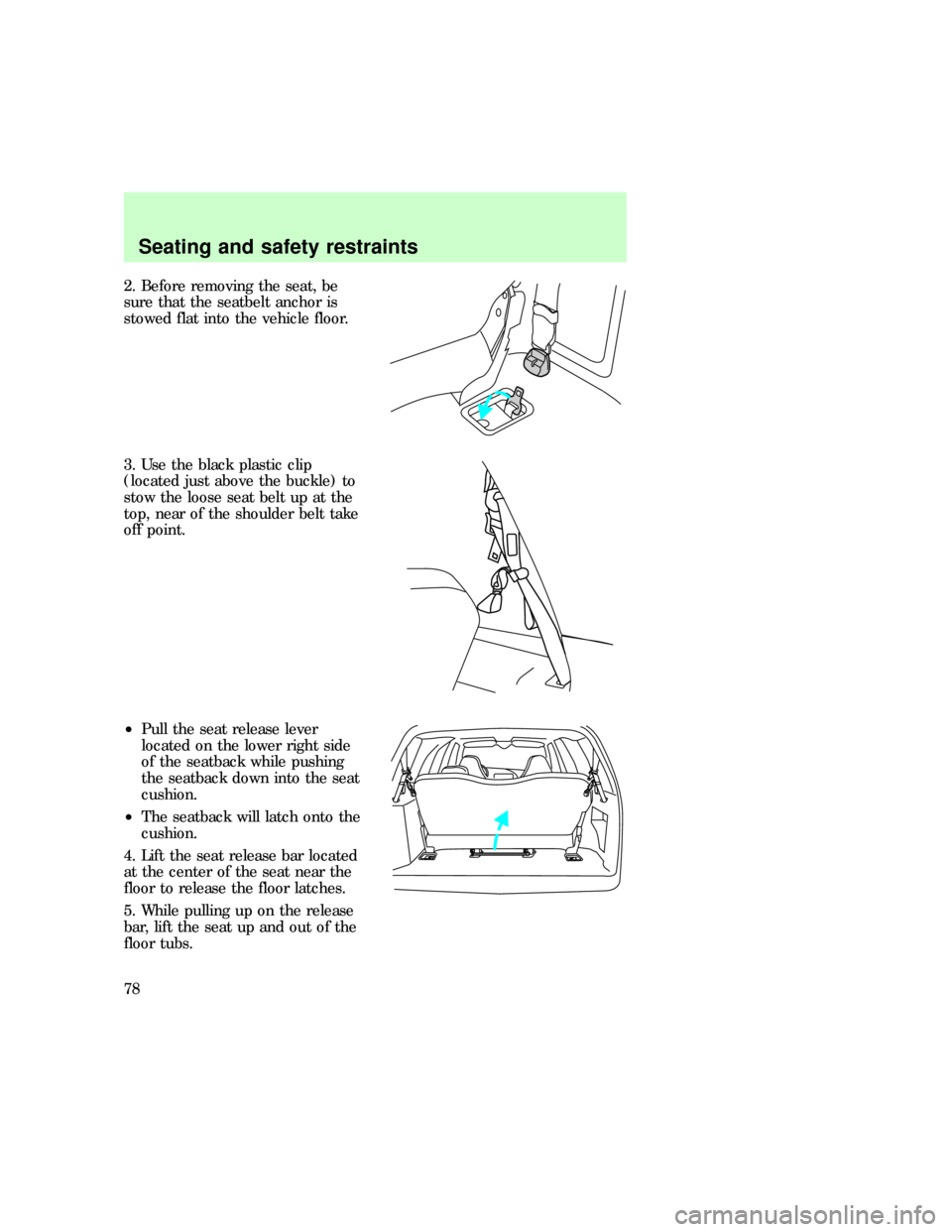
2. Before removing the seat, be
sure that the seatbelt anchor is
stowed flat into the vehicle floor.
3. Use the black plastic clip
(located just above the buckle) to
stow the loose seat belt up at the
top, near of the shoulder belt take
off point.
²Pull the seat release lever
located on the lower right side
of the seatback while pushing
the seatback down into the seat
cushion.
²The seatback will latch onto the
cushion.
4. Lift the seat release bar located
at the center of the seat near the
floor to release the floor latches.
5. While pulling up on the release
bar, lift the seat up and out of the
floor tubs.
Seating and safety restraints
78
Page 78 of 224
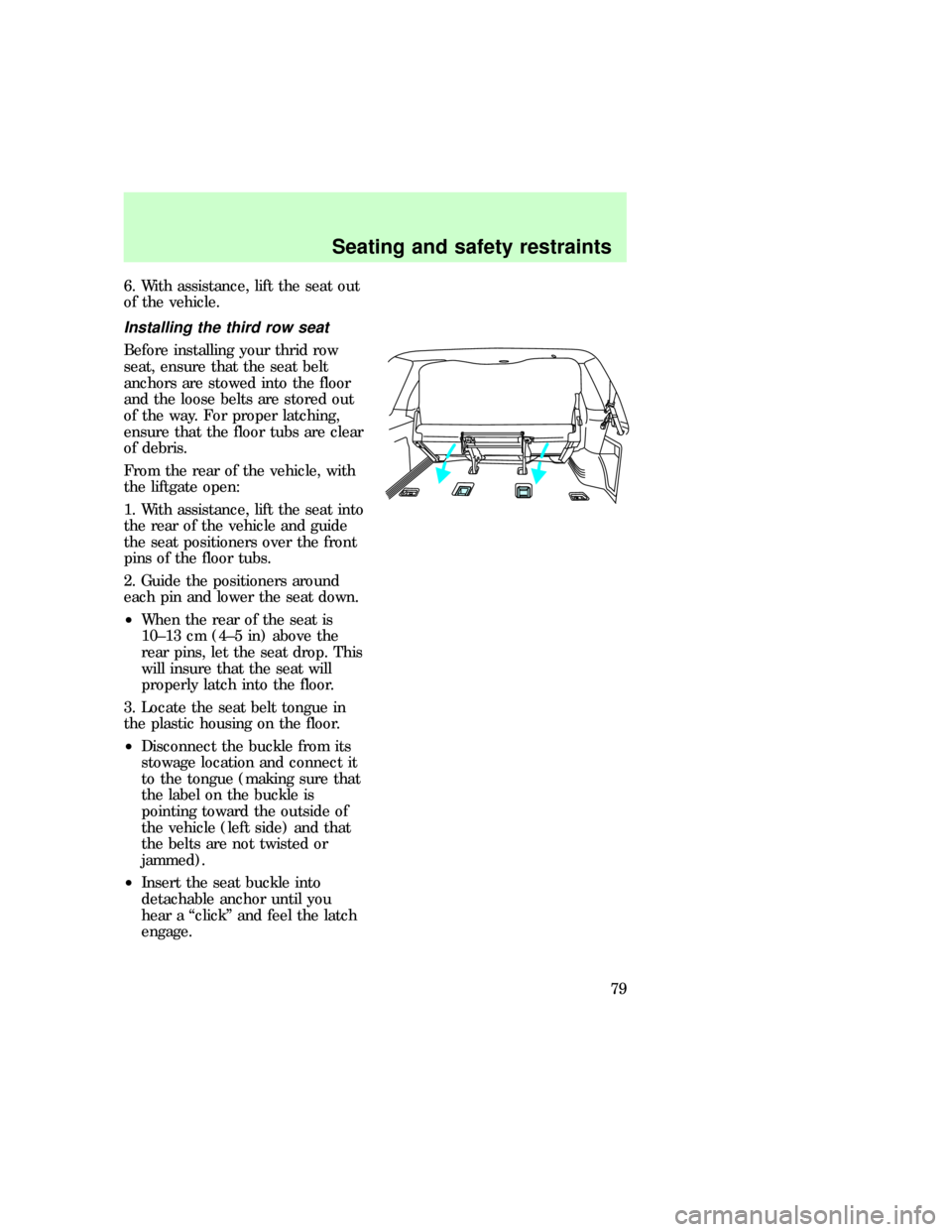
6. With assistance, lift the seat out
of the vehicle.
Installing the third row seat
Before installing your thrid row
seat, ensure that the seat belt
anchors are stowed into the floor
and the loose belts are stored out
of the way. For proper latching,
ensure that the floor tubs are clear
of debris.
From the rear of the vehicle, with
the liftgate open:
1. With assistance, lift the seat into
the rear of the vehicle and guide
the seat positioners over the front
pins of the floor tubs.
2. Guide the positioners around
each pin and lower the seat down.
²When the rear of the seat is
10±13 cm (4±5 in) above the
rear pins, let the seat drop. This
will insure that the seat will
properly latch into the floor.
3. Locate the seat belt tongue in
the plastic housing on the floor.
²Disconnect the buckle from its
stowage location and connect it
to the tongue (making sure that
the label on the buckle is
pointing toward the outside of
the vehicle (left side) and that
the belts are not twisted or
jammed).
²Insert the seat buckle into
detachable anchor until you
hear a ªclickº and feel the latch
engage.
exd_installation_third
Seating and safety restraints
79
Page 79 of 224
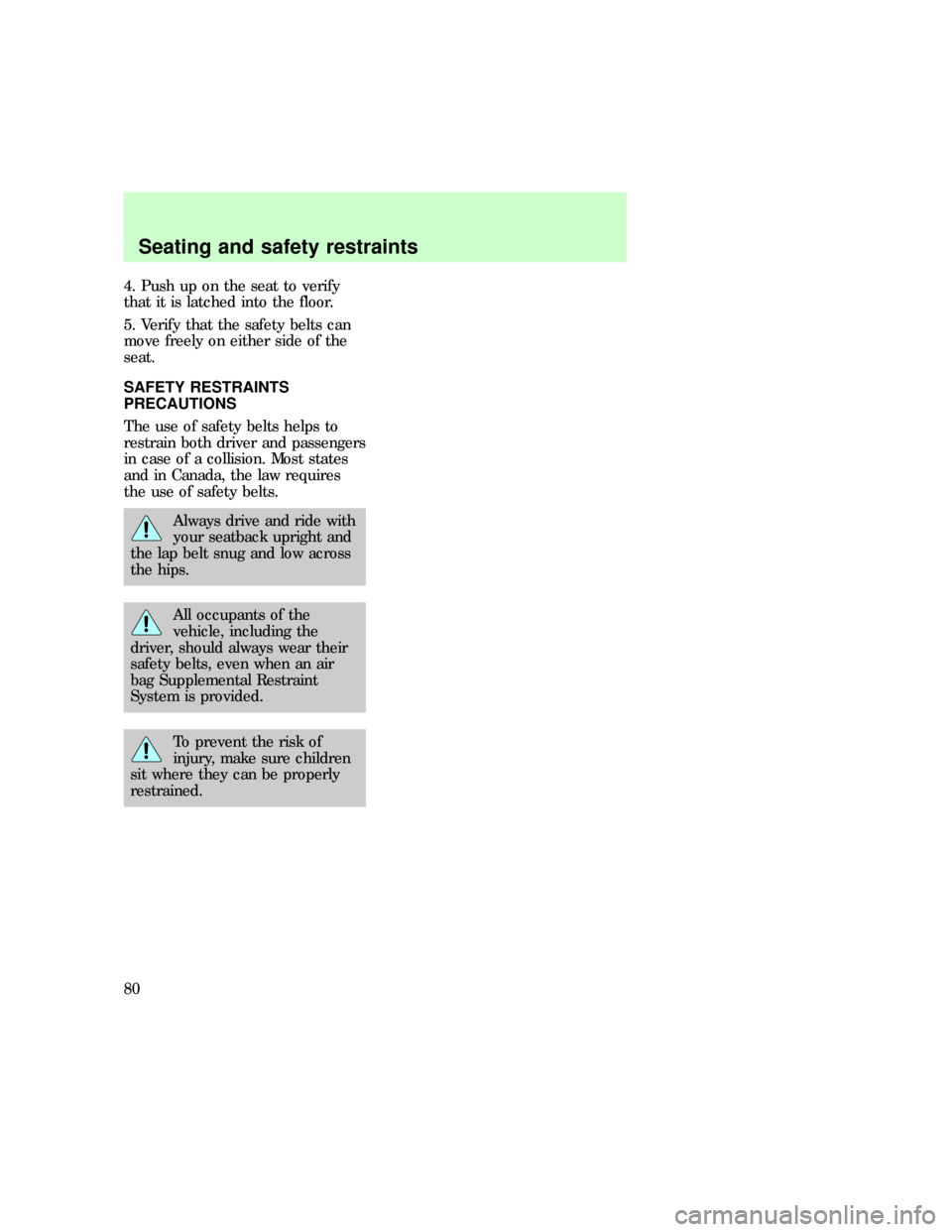
4. Push up on the seat to verify
that it is latched into the floor.
5. Verify that the safety belts can
move freely on either side of the
seat.
SAFETY RESTRAINTS
PRECAUTIONS
The use of safety belts helps to
restrain both driver and passengers
in case of a collision. Most states
and in Canada, the law requires
the use of safety belts.
Always drive and ride with
your seatback upright and
the lap belt snug and low across
the hips.
All occupants of the
vehicle, including the
driver, should always wear their
safety belts, even when an air
bag Supplemental Restraint
System is provided.
To prevent the risk of
injury, make sure children
sit where they can be properly
restrained.
exd_precautions
Seating and safety restraints
80
Page 80 of 224
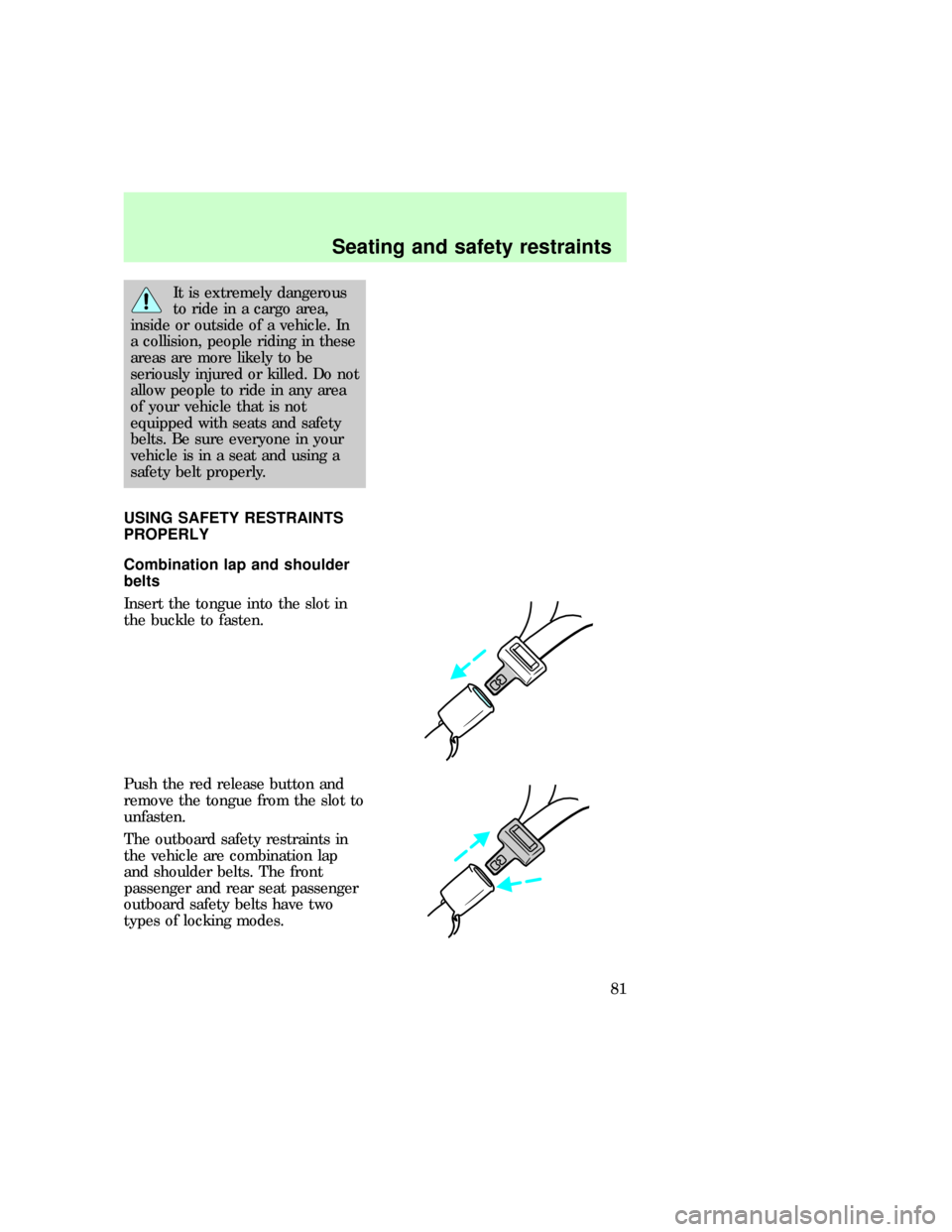
It is extremely dangerous
to ride in a cargo area,
inside or outside of a vehicle. In
a collision, people riding in these
areas are more likely to be
seriously injured or killed. Do not
allow people to ride in any area
of your vehicle that is not
equipped with seats and safety
belts. Be sure everyone in your
vehicle is in a seat and using a
safety belt properly.
USING SAFETY RESTRAINTS
PROPERLY
Combination lap and shoulder
belts
Insert the tongue into the slot in
the buckle to fasten.
Push the red release button and
remove the tongue from the slot to
unfasten.
The outboard safety restraints in
the vehicle are combination lap
and shoulder belts. The front
passenger and rear seat passenger
outboard safety belts have two
types of locking modes.
exd_proper_use
exd_combo_lap_shoulder
exd_emergency_locking
Seating and safety restraints
81
Page 81 of 224
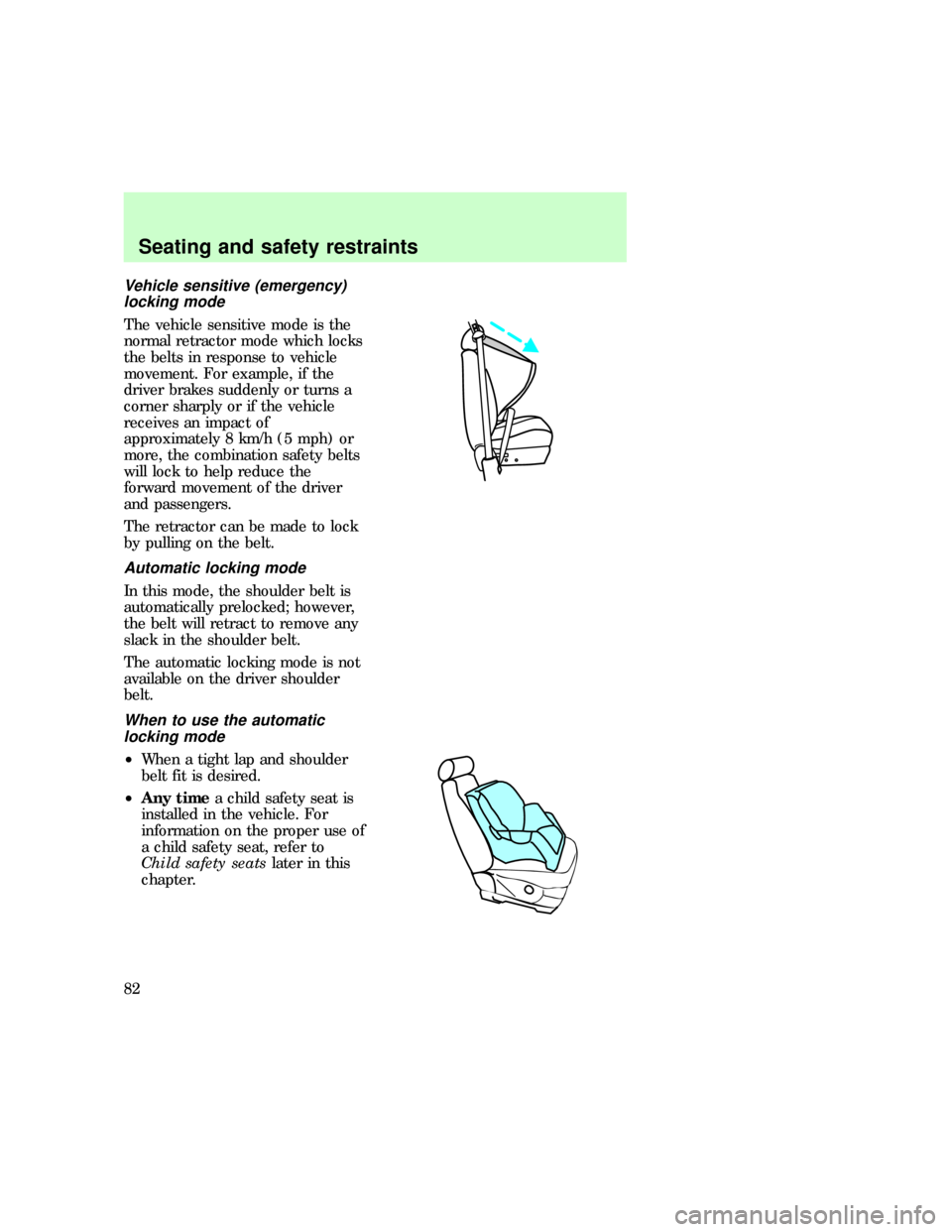
Vehicle sensitive (emergency)
locking mode
The vehicle sensitive mode is the
normal retractor mode which locks
the belts in response to vehicle
movement. For example, if the
driver brakes suddenly or turns a
corner sharply or if the vehicle
receives an impact of
approximately 8 km/h (5 mph) or
more, the combination safety belts
will lock to help reduce the
forward movement of the driver
and passengers.
The retractor can be made to lock
by pulling on the belt.
Automatic locking mode
In this mode, the shoulder belt is
automatically prelocked; however,
the belt will retract to remove any
slack in the shoulder belt.
The automatic locking mode is not
available on the driver shoulder
belt.
When to use the automatic
locking mode
²When a tight lap and shoulder
belt fit is desired.
²Any timea child safety seat is
installed in the vehicle. For
information on the proper use of
a child safety seat, refer to
Child safety seatslater in this
chapter.
exd_automatic_locking_mode
exd_when_to_use_almode
exd_using_auto_locking_mode
Seating and safety restraints
82
Page 82 of 224

Using automatic locking mode
The automatic locking mode must
be used when installing a child
safety seat in any outboard
passenger seat.
1. Buckle the combination lap and
shoulder belt.
2. Grasp the shoulder belt portion
and pull downward until the entire
belt is extracted.
3. Allow the belt to retract. As the
belt retracts, you will hear a
clicking sound. This indicates that
the safety belt is now in the
automatic locking mode.
Canceling automatic locking
mode
Disconnect the combination lap
and shoulder belt and allow it to
completely retract. This will cancel
the automatic locking mode and
activate the vehicle sensitive
(emergency) locking mode.
Adjusting the lap belt
A lap belt is located in the center
of the rear seat and third row seat
(if equipped).
Because the lap belt does not have
a retractor to automatically adjust
itself during vehicle movement, the
lap belt must be adjusted before
use.
exd_canceling_auto_locking_mod
exd_adjusting_lap_belt
Seating and safety restraints
83